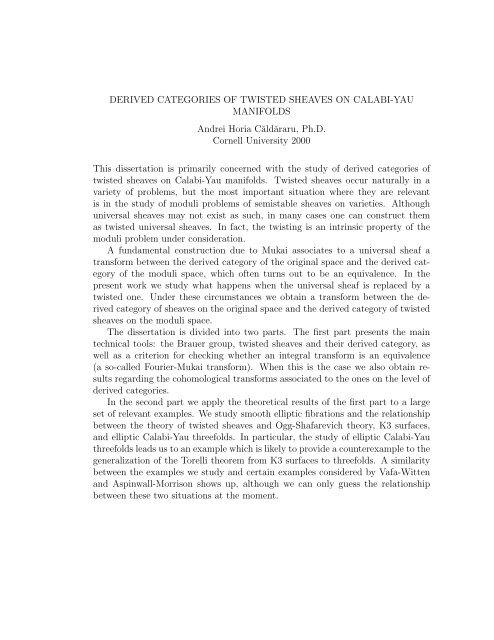derived categories of twisted sheaves on calabi-yau manifolds
derived categories of twisted sheaves on calabi-yau manifolds
derived categories of twisted sheaves on calabi-yau manifolds
Create successful ePaper yourself
Turn your PDF publications into a flip-book with our unique Google optimized e-Paper software.
DERIVED CATEGORIES OF TWISTED SHEAVES ON CALABI-YAU<br />
MANIFOLDS<br />
Andrei Horia Căldăraru, Ph.D.<br />
Cornell University 2000<br />
This dissertati<strong>on</strong> is primarily c<strong>on</strong>cerned with the study <str<strong>on</strong>g>of</str<strong>on</strong>g> <str<strong>on</strong>g>derived</str<strong>on</strong>g> <str<strong>on</strong>g>categories</str<strong>on</strong>g> <str<strong>on</strong>g>of</str<strong>on</strong>g><br />
<str<strong>on</strong>g>twisted</str<strong>on</strong>g> <str<strong>on</strong>g>sheaves</str<strong>on</strong>g> <strong>on</strong> Calabi-Yau <strong>manifolds</strong>. Twisted <str<strong>on</strong>g>sheaves</str<strong>on</strong>g> occur naturally in a<br />
variety <str<strong>on</strong>g>of</str<strong>on</strong>g> problems, but the most important situati<strong>on</strong> where they are relevant<br />
is in the study <str<strong>on</strong>g>of</str<strong>on</strong>g> moduli problems <str<strong>on</strong>g>of</str<strong>on</strong>g> semistable <str<strong>on</strong>g>sheaves</str<strong>on</strong>g> <strong>on</strong> varieties. Although<br />
universal <str<strong>on</strong>g>sheaves</str<strong>on</strong>g> may not exist as such, in many cases <strong>on</strong>e can c<strong>on</strong>struct them<br />
as <str<strong>on</strong>g>twisted</str<strong>on</strong>g> universal <str<strong>on</strong>g>sheaves</str<strong>on</strong>g>. In fact, the twisting is an intrinsic property <str<strong>on</strong>g>of</str<strong>on</strong>g> the<br />
moduli problem under c<strong>on</strong>siderati<strong>on</strong>.<br />
A fundamental c<strong>on</strong>structi<strong>on</strong> due to Mukai associates to a universal sheaf a<br />
transform between the <str<strong>on</strong>g>derived</str<strong>on</strong>g> category <str<strong>on</strong>g>of</str<strong>on</strong>g> the original space and the <str<strong>on</strong>g>derived</str<strong>on</strong>g> category<br />
<str<strong>on</strong>g>of</str<strong>on</strong>g> the moduli space, which <str<strong>on</strong>g>of</str<strong>on</strong>g>ten turns out to be an equivalence. In the<br />
present work we study what happens when the universal sheaf is replaced by a<br />
<str<strong>on</strong>g>twisted</str<strong>on</strong>g> <strong>on</strong>e. Under these circumstances we obtain a transform between the <str<strong>on</strong>g>derived</str<strong>on</strong>g><br />
category <str<strong>on</strong>g>of</str<strong>on</strong>g> <str<strong>on</strong>g>sheaves</str<strong>on</strong>g> <strong>on</strong> the original space and the <str<strong>on</strong>g>derived</str<strong>on</strong>g> category <str<strong>on</strong>g>of</str<strong>on</strong>g> <str<strong>on</strong>g>twisted</str<strong>on</strong>g><br />
<str<strong>on</strong>g>sheaves</str<strong>on</strong>g> <strong>on</strong> the moduli space.<br />
The dissertati<strong>on</strong> is divided into two parts. The first part presents the main<br />
technical tools: the Brauer group, <str<strong>on</strong>g>twisted</str<strong>on</strong>g> <str<strong>on</strong>g>sheaves</str<strong>on</strong>g> and their <str<strong>on</strong>g>derived</str<strong>on</strong>g> category, as<br />
well as a criteri<strong>on</strong> for checking whether an integral transform is an equivalence<br />
(a so-called Fourier-Mukai transform). When this is the case we also obtain results<br />
regarding the cohomological transforms associated to the <strong>on</strong>es <strong>on</strong> the level <str<strong>on</strong>g>of</str<strong>on</strong>g><br />
<str<strong>on</strong>g>derived</str<strong>on</strong>g> <str<strong>on</strong>g>categories</str<strong>on</strong>g>.<br />
In the sec<strong>on</strong>d part we apply the theoretical results <str<strong>on</strong>g>of</str<strong>on</strong>g> the first part to a large<br />
set <str<strong>on</strong>g>of</str<strong>on</strong>g> relevant examples. We study smooth elliptic fibrati<strong>on</strong>s and the relati<strong>on</strong>ship<br />
between the theory <str<strong>on</strong>g>of</str<strong>on</strong>g> <str<strong>on</strong>g>twisted</str<strong>on</strong>g> <str<strong>on</strong>g>sheaves</str<strong>on</strong>g> and Ogg-Shafarevich theory, K3 surfaces,<br />
and elliptic Calabi-Yau threefolds. In particular, the study <str<strong>on</strong>g>of</str<strong>on</strong>g> elliptic Calabi-Yau<br />
threefolds leads us to an example which is likely to provide a counterexample to the<br />
generalizati<strong>on</strong> <str<strong>on</strong>g>of</str<strong>on</strong>g> the Torelli theorem from K3 surfaces to threefolds. A similarity<br />
between the examples we study and certain examples c<strong>on</strong>sidered by Vafa-Witten<br />
and Aspinwall-Morris<strong>on</strong> shows up, although we can <strong>on</strong>ly guess the relati<strong>on</strong>ship<br />
between these two situati<strong>on</strong>s at the moment.
















